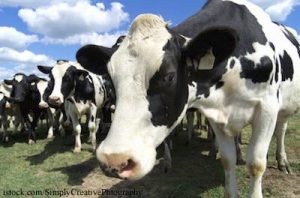The FDA has finalized a rule designed to reduce the risk of bovine spongiform encephalopathy (BSE), sometimes called “mad cow disease” in human food. This rule covers definitions for prohibited cattle materials in food, dietary supplements, and cosmetics.
 The materials include specified risk materials (SRMs) of brain, skull, eyes, trigeminal ganglia, spinal corn, vertebral column, and dorsal root ganglia of cattle 30 months of age and older, and the tonsils and distal ileum of the small instating of all cattle. Also prohibited are the small intestine from all cattle unless the distal ileum has been properly removed, material from non ambulatory cattle, and material from cattle not inspected and passed, or mechanically separated beef.
The materials include specified risk materials (SRMs) of brain, skull, eyes, trigeminal ganglia, spinal corn, vertebral column, and dorsal root ganglia of cattle 30 months of age and older, and the tonsils and distal ileum of the small instating of all cattle. Also prohibited are the small intestine from all cattle unless the distal ileum has been properly removed, material from non ambulatory cattle, and material from cattle not inspected and passed, or mechanically separated beef.
The rule confirms that milk and milk products, hides and hide-derived products, tallow with no more than 0.15 percent insoluble impurities, and tallow derivatives are not prohibited. Gelatin is not considered a prohibited cattle material if it is manufactured using the customary industry processes.
The U.S. has had measures to protect against BSE for years. The government considers the risk of human exposure to the BSE agent from FDA-regulated human food and cosmetics to be negligible.
The United Kingdom has had many cases of Creutzfeldt-Jakob Disease, the human version of “mad cow disease,” in the past. As of December 1, 2003, 143 human cases of vCJD (variant Creutzfeldt-Jakob Disease) had been identified in Britain. The prion in cows that causes this illness, BSE, is the same agent that causes vCJD in people. The illness was first described in 1996 in the U.K.
There have been three human cases of vCJD in humans in the United States from 1996 to 2014, but there is strong evidence that two of the three cases were exposed to the prion in the U.K. The third was most likely exposed while living in Saudi Arabia.
In the last 13 years, there have been four cases of BSE in cattle in the United States. There was one in California in 2012, one in Alabama in 2006, one in Texas in 2005, and one in Washington state in 2003. Those cows were all over 10 years old.
The animal in Washington state was non ambulatory at slaughter and was most likely imported from Canada. Unfortunately, beef from the slaughtered cow had been processed for human consumption because a USDA veterinary medical officer examined the cow before and after slaughter. The animal’s condition was attributed to complications from calving.
Tissues considered to be at high risk for BSE transmission were removed and examined, and the prion was found. On December 23, 2003, the USDA announced the recall of all beef slaughtered from that particular plant on December 9, 2003.




